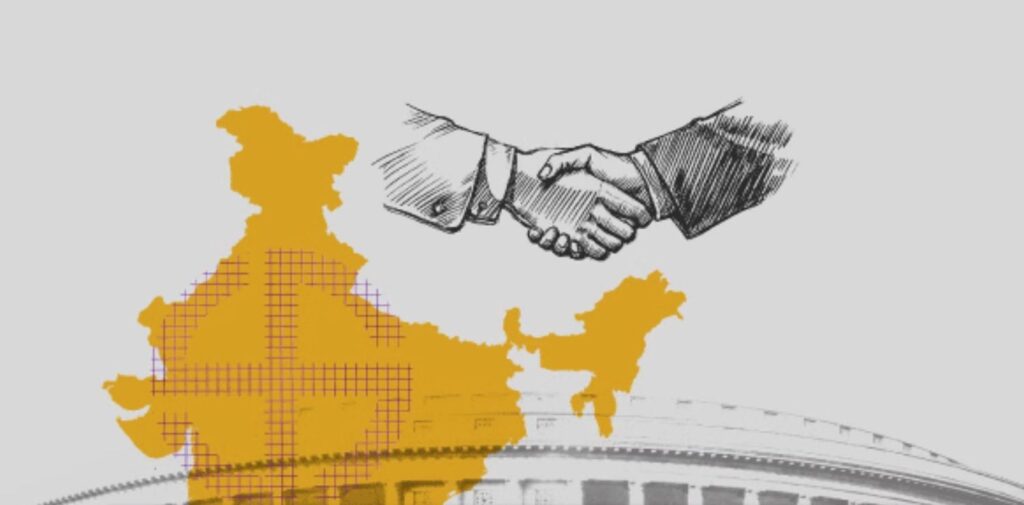The political landscape of India has witnessed significant transformations in the past few decades. One of the most notable changes has been the growing influence of regional political parties. Post-2000, these parties have played an increasingly important role in shaping the country’s political discourse. While national parties like the Bharatiya Janata Party (BJP) and Indian National Congress (INC) continue to dominate the political scene, regional parties have carved out their own space and become key players in both state and national politics. This article explores the impact of regional political parties on Indian politics, focusing on their influence on governance, national policies, coalition politics, and electoral outcomes.
Rise of Regional Parties: The Changing Political Scene
The rise of regional political parties in India can be traced back to the post-independence era, but it has gained significant momentum since the 1990s. In the early years of independence, the Indian National Congress (INC) was the dominant force in national politics, with little opposition. However, as India grew more diverse and its states became more assertive about their regional identity, regional parties began to emerge as influential players.
Post-2000, this trend became more pronounced. The growth of regional political parties is partly due to the growing discontent with national parties that often failed to address the unique needs and concerns of specific states. Parties like the Trinamool Congress (TMC) in West Bengal, the Samajwadi Party (SP) in Uttar Pradesh, the Dravida Munnetra Kazhagam (DMK) in Tamil Nadu, and the Aam Aadmi Party (AAP) in Delhi have gained significant traction in their respective states, challenging the dominance of national parties.
These regional parties have often been able to tap into local sentiments, providing a voice for the people who feel marginalized by national parties. This shift in the political landscape has been crucial in the decentralization of political power, where the voices of smaller states and regional communities have found more representation.

Influence on National Politics: The Role in Coalition Governments
One of the most significant impacts of regional parties in Indian politics has been their role in national coalition governments. India’s political system, characterized by its multi-party setup, has made it increasingly difficult for any one party to secure an absolute majority in the Lok Sabha (the lower house of Parliament). As a result, coalition politics has become a norm, and regional parties have played a decisive role in this arena.
In the post-2000 era, several national governments have been formed with the support of regional parties. For instance, the United Progressive Alliance (UPA), led by the Congress Party from 2004 to 2014, was heavily reliant on regional parties like the DMK, TMC, Nationalist Congress Party (NCP), and others. Similarly, the National Democratic Alliance (NDA), led by the BJP, has also seen the participation of key regional parties like the Shiv Sena, Janata Dal (United), and others. These regional parties have often held the balance of power, forcing national parties to accommodate their demands in exchange for support.
The influence of regional parties in coalition governments has meant that national policies must take regional concerns into account. Regional parties often push for policies that are tailored to the specific needs of their states, whether it’s related to resource distribution, economic development, or cultural issues. For example, the demand for more autonomy or special status for certain regions, such as Jammu and Kashmir or Telangana, has been championed by regional parties.

Decentralization of Political Power: Empowering States
Regional parties have played a crucial role in the decentralization of political power in India. Prior to the rise of these parties, power was largely concentrated in the hands of national parties, with state governments often sidelined. However, the growing influence of regional parties has led to a shift in this dynamic. States now have a greater say in national governance, with regional leaders becoming key players in the decision-making process.
This decentralization of power has had a positive impact on governance. Regional parties, by virtue of their local presence and knowledge of state-specific issues, are often better equipped to address the concerns of the people in their states. This has led to more localized governance and policies that are more attuned to the needs of the people.
For example, the governance style of West Bengal’s Mamata Banerjee or Uttar Pradesh’s Akhilesh Yadav is deeply rooted in their state’s unique political and social fabric. These leaders have often pushed for state-centric development models, focused on issues such as rural development, local infrastructure, and welfare schemes. This has allowed for more effective administration at the state level and has improved the quality of governance in some areas.
Regional Parties and Their Role in Electoral Politics
The growing influence of regional parties has also had a profound impact on electoral politics in India. In recent elections, these parties have been able to build strong regional coalitions that can rival the national parties in their respective states. This has led to a more fragmented electoral landscape, where national parties find it increasingly difficult to dominate the political scene across the entire country.
In state elections, regional parties often emerge as the dominant force. For instance, in the 2015 Bihar elections, Nitish Kumar’s JD(U) and Lalu Prasad Yadav’s RJD formed a successful alliance, defeating the BJP-led NDA. Similarly, the TMC has dominated politics in West Bengal, pushing aside the Congress and the Left Front. In Delhi, the Aam Aadmi Party (AAP) has emerged as a formidable force, effectively challenging both the BJP and Congress.
Moreover, regional parties often have a significant impact on national elections as well. Even though they may not secure a large number of seats in the Lok Sabha, their support can be critical in determining which party forms the government at the Centre. In the 2019 general elections, for instance, while the BJP won a landslide victory, regional parties like the TMC, YSR Congress, and BJD secured significant numbers of seats and were able to wield influence in shaping national politics.
Regional Identity and Its Political Impact
One of the key factors behind the rise of regional parties is the growing importance of regional identity. India’s diverse population, with its various languages, cultures, and traditions, has led to the rise of political movements that seek to assert regional identity and demand greater autonomy. Regional political parties often play a vital role in these movements, representing the aspirations and concerns of their communities.
For instance, the DMK in Tamil Nadu has long been a champion of the Tamil identity and language, pushing for greater rights for the Tamil people. Similarly, parties like the Shiv Sena in Maharashtra have focused on promoting the interests of Marathi-speaking people. In the northeastern states, regional parties have called for greater autonomy and protection of indigenous cultures and resources. These issues are central to the campaigns of many regional parties, which can mobilize local populations by invoking regional pride and identity.

Challenges Faced by Regional Parties
While regional parties have made significant strides in Indian politics, they also face numerous challenges. One of the major issues is the limited scope of their influence. Most regional parties are confined to a single state or a specific region, which limits their ability to play a substantial role in national politics. Their influence often wanes when they attempt to extend their reach beyond their home turf.
Furthermore, regional parties sometimes struggle with internal divisions and leadership challenges, which can weaken their political standing. In several instances, leadership disputes within regional parties have led to splits, weakening their ability to challenge national parties effectively.
Conclusion: Regional Political Parties
The impact of regional political parties in Indian politics post-2000 cannot be underestimated. These parties have not only reshaped the electoral landscape but also redefined the nature of governance in India. By pushing for state-centric policies, promoting regional identities, and forming crucial alliances in coalition politics, regional parties have significantly influenced both state and national-level politics.
While challenges remain, the rise of regional parties marks a new era in Indian politics. As the country continues to evolve, the importance of regional political forces will only increase, and their role in shaping India’s political future will be crucial. Whether it’s through greater decentralization of power, influencing national policies, or representing the aspirations of local communities, regional parties will continue to play a significant role in India’s democracy.




